

 The Accurate Reloading Forums
The Accurate Reloading Forums  THE ACCURATE RELOADING.COM FORUMS
THE ACCURATE RELOADING.COM FORUMS  Guns, Politics, Gunsmithing & Reloading
Guns, Politics, Gunsmithing & Reloading  Reloading
Reloading  Overcoming 1Fire M1A Brass
Overcoming 1Fire M1A BrassGo  | New  | Find  | Notify  | Tools  | Reply  |  |
| One of Us |
Is the use of a small base die the only solution? to overcome the buldge you get from firing brass in M1A platform? Rather not buy small base die so figured I'd ask. | ||
|
| One of Us |
I never owned a small base die and I shoot lots of semi autos. And I have 3 M1As and they do not bulge the brass. You might have another problem like a big chamber. There is no reason to get bulged cases from one. | |||
|
| one of us |
Gotta picture of the "bulge"? | |||
|
| One of Us |
The 7.62x51mm cartridge is a high pressure cartridge. The bulge as you say is best handled by the Small Base die. In my semi-auto rifles,I always use the SB die and hand never had a FTF due to an out of spec casing. I've been shooting semi-autos rifles for 50 years now and learned this tip at an early age. Gulf of Tonkin Yacht Club NRA Endowment Member President NM MILSURPS | |||
|
| One of Us |
If your bulge is above the web near the base of the cartridge then I get the same thing in my 03A3. I only neck size because the chamber, a military cut, is large by "normal" standards even though the headspacing is correct. Leaving the case in the expanded form and only neck sizing the first 3/4 of the neck allows my rounds to be better centered in the chamber. I know that you can't just neck size in the M1A for chambering reasons but as long as the reloads chamber consistently you don't have to worry about a small base die or the "bulge". Speer, Sierra, Lyman, Hornady, Hodgdon have reliable reloading data. You won't find it on so and so's web page. | |||
|
| One of Us |
Post a pic of the bulge. I say there is no need for small base dies at all. There is no reason that an M1A would have any more bulge than a Rem 700 so over working your brass is not needed. If you mean you are getting a slight enlarging of the brass above the solid head, well that is not a bulge and a FL sizing die will work fine. And what PaulS said. | |||
|
| one of us |
If I remember correctly Small Base dies were originaly made for reloading ammo for the Browning semiauto sporting rifles, as they had tight chambers. At least it I first remembered hereing about them for that use... Then later, when people started getting hold of surplus 7.62 brass fired in M 60 machineguns, These cases had excpanded so much that regular dies would not size them down enough to fit many Spoering rifles, including M1-A's. I have reloaded for a lot of M1-A's and many 308 Match rifles and I have never used small base dies, even on some M 60 brass I had. One of the best things you can get is a chamber measuring die designed to measure the headspace of a loaded or fired case. If I remember correctly I think they company is Mo's, or Moe's. We always called them a Mo's/moe's?? gage. DOUBLE RIFLE SHOOTERS SOCIETY | |||
|
| one of us |
From Sierra. Despite the oft-repeated advice that autoloaders, pumpguns and lever-actions require small base dies, the Service Rifles may be the exception that proves the rule. While it’s true that all of these action types lack the powerful camming forces of a bolt-action, the more generous chamber dimensions common to most Service Rifles are normally compatible with standard dies. Please understand that this is a general statement, and that there are exceptions to this. The point is, you don’t need to automatically go to a small base die set. Most of the standard reloading dies produced by reputable firms, such as RCBS, will resize fired brass properly to work in these rifles. | |||
|
| One of Us |
I use standard LEE 308 dies for my M1A1, 308 Garand and my bolt trash rifles as well. I have not encountered any problems. Rusty We Band of Brothers! DRSS, NRA & SCI Life Member "I am rejoiced at my fate. Do not be uneasy about me, for I am with my friends." ----- David Crockett in his last letter (to his children), January 9th, 1836 "I will never forsake Texas and her cause. I am her son." ----- Jose Antonio Navarro, from Mexican Prison in 1841 "for I have sworn upon the altar of god eternal hostility against every form of tyranny over the mind of man." Thomas Jefferson Declaration of Arbroath April 6, 1320-“. . .It is not for glory, nor riches, nor honours that we are fighting, but for freedom - for that alone, which no honest man gives up but with life itself.” | |||
|
| One of Us |
You will need to post a picture of your case budge as I have no idea what you are talking about. The first and foremost consideration for reloading for Garands and M1a’s is safety, then function. The Garand based designs are early semi automatic designs and lack safety features that were included in later designs. First and foremost, like all other mechanisms with a free floating firing pin, this design relies on primer insensitivity to prevent slamfires. Unlike some later designs, this mechanism does not have a mechanical means of preventing firing pin contact with the primer before the lugs rotate into battery. Ar15’s, for example, there lots of reported slamfires, but no reports of out of battery slamfires. That is because the AR15 firing pin is positively retracted until lug cam down. The firing pin only extends once the bolt head rotates into battery. This is not the case with the Garand mechanism, this mechanism will slamfire in battery and out of battery. I suspect on a slamfire per rifle basis the SKS has more than any other type. And yet, they don’t slamfire out of battery. This is because the breech face does not line up with the cartridge base until lockup. Look at this insanely dangerous demonstration by Murray’s Guns: http://www.youtube.com/watch?v=xj3QtnUWCwQ The firing pin is fixed forward so it is protruding out of the bolt face, so what you have is clearly a slamfire, and yet, the SKS does not blow up. If this was a Garand action the back of the receiver would be blown off before the clip was empty. Slamfires are very rare events, but they do happen, and out of battery events are even rarer, but when they happen things get messy: 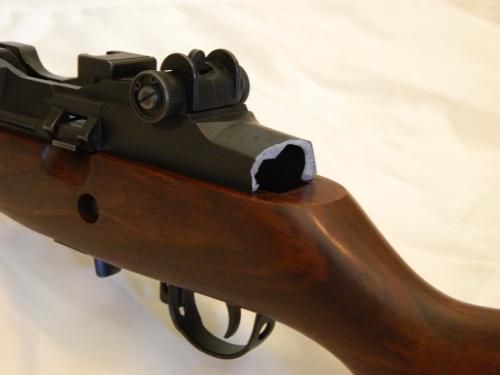 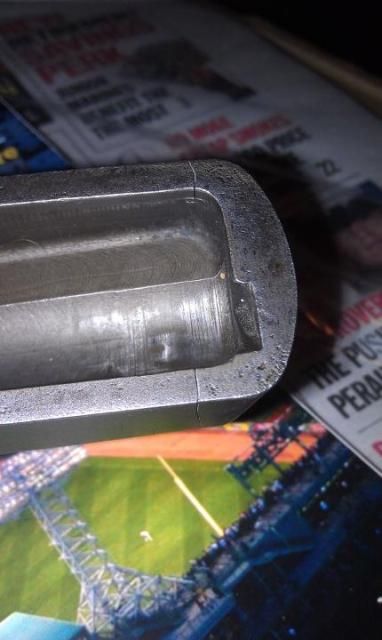 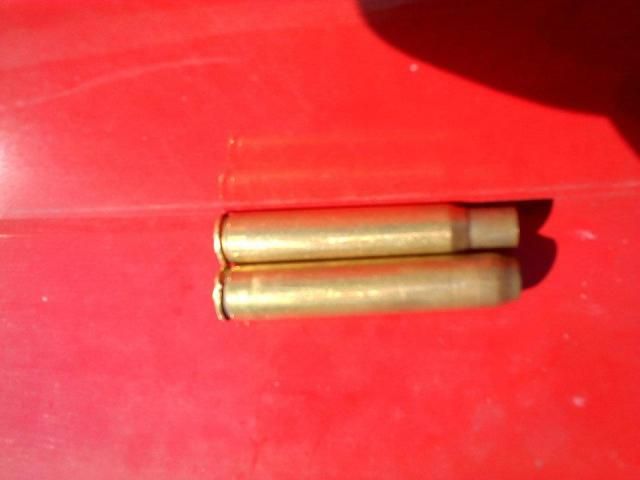 So, what does this have to do with dies? The most likely condition to cause an out of battery slamfire in a Garand type action is a tight case fit and a sensitive primer. The appropriate primers to use in this mechanism are the “mil spec” primers. The US military created, manufactured, and loaded these primers in US service rifle ammunition because their low sensitivity reduces the frequency of slamfires to an acceptable level (about 1:50 million) and yet these primers are sensitive enough to ignite in cold weather. Every manufacturer makes a mil spec primer for the military but of American manufacturers, only CCI sells their #34 primer to the public. Tula sells a 7.62 mil spec primer and it is an excellent primer . Federal at least has introduced its mil spec small rifle primer, and that is probably in response to the huge number of AR15’s introduced to the commercial market since 2000. Prior to 2000 you could get into some heated arguments with slamfire deniers about whether an AR15 could slamfire. Everyone had heard of, or seen, slamfires in Garands and M1a’s, but no one had heard of a AR15 slamfiring. A decade later and deniers still deign the moon in the sky exists, but enough slamfires in AR15’s have happened that Federal is now introducing its mil spec primer for AR15’s. We should encourage all primer manufacturers to introduce all of their commercial primer lines to the civilian market place. Unfortunately, commercial primers are more sensitive than mil spec primers and have more reported slamfires. But understand, this mechanism has slamfired in battery and out of battery with every American primer on the market, and this is a risk with primers, you can buy primers that are on the average “less sensitive” but no manufacturer can guarantee the sensitivity of each and every primer they make. Primers vary by sensitivity within a lot, and once in a while, you get a sensitive primer. These are rare, probably not as rare as dud primers, but they happen. Again, what does this have to do with dies? Given that you cannot 100 % determine the sensitivity of each and every primer you buy, you can control factors that make it less likely to have an out of battery slamfire. The first is to size the case such that there is no delay to the bolt lugs going into battery. If that bolt has to crunch fit a case to the chamber, that free floating firing pin is rebounding off the primer, at its highest velocity, and the lugs may be out of battery. Given enough tries it is only a matter of time till a sensitive primer ignites.  It is therefore prudent to size cases with small base dies. It is safety critical, whether you are using a small base die or a standard die to use a cartridge headspace gage when you set up your die. Push the shoulder back about 0.003” if you know the rifle headspace or simply size to gage minimum. Some other habits to learn: never put a round in the chamber and drop the bolt. Always feed from the magazine. Stripping a round from the magazine slows the bolt down, and slamfires are all about firing pin kinetic energy. Even though high primers are the most common cause of misfires, it is never prudent to have a high primer. It is good practice to ream primer pockets to depth and inspect all primers to ensure they are below the case head. Given a shallow pocket and a properly seated primer, in a fast moving automatic mechanism, the potential for primer ignition is real. I have 308 and 30-6 gages, cut by Gene Barnett which are a little out of the ordinary. He cut these gages with his chambering reamer. Standard cartridge headspace gages are cut with a special reamer that is wide in the middle. A standard cartridge headspace gage measures length, not “fatness”. A reamer cut headspace gage will show you if the case is too long and too “fat” for that chamber. I have a number of 308 small base dies, and I still have my Lee standard die. I sized a number of my match cases in the Lee die. All of them dropped in the reamer cut case gage. So, if you said you don’t need small base dies, you would be correct most of the time. So now I had to scratch around trying to find cases that would prove my point. These two cases are once fired range pickup brass that I found in my brass box. I had to go through about 20 cases before I found a set of really ballooned cases. On the right is the Barnett reamer cut gage. 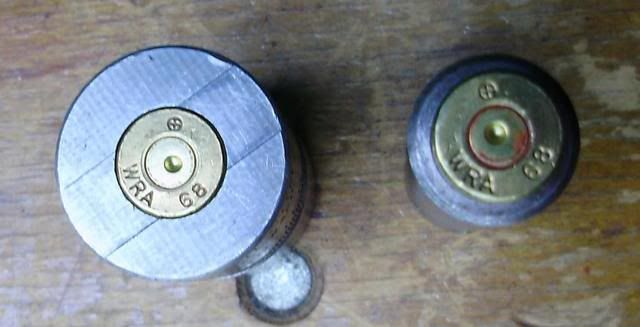 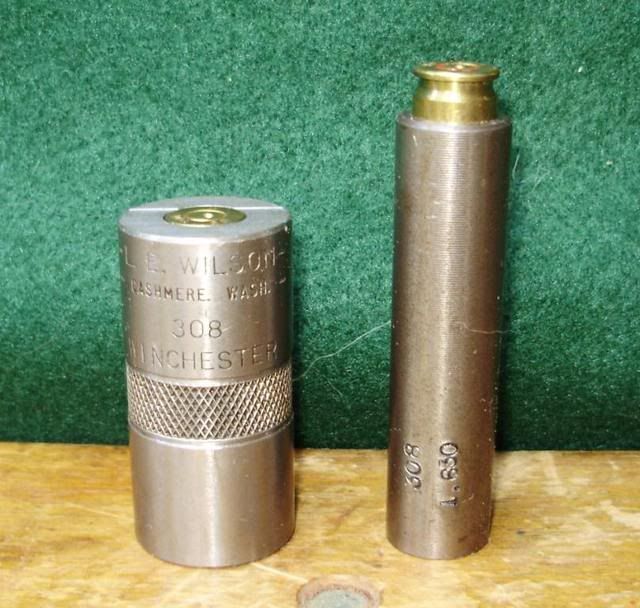 If you notice one case has completed dropped into the Wilson cartridge headspace gage, while the other has not dropped into the Barnett reamer cut gage. This shows how much they have swelled up after being fired. Must have been a big chamber. The second picture is of the fattest of the group after sizing in with Lee Die. I trimmed the thing to make sure that the case neck did not interfere with the throat in the gage. 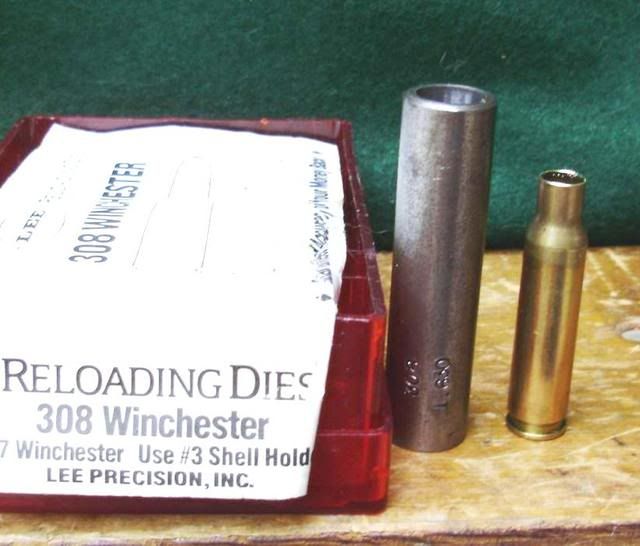 Hopefully you can see that the case did not drop all the way in the case gage. At least on its own. It would have taken a good hard push to get that base all the way in. 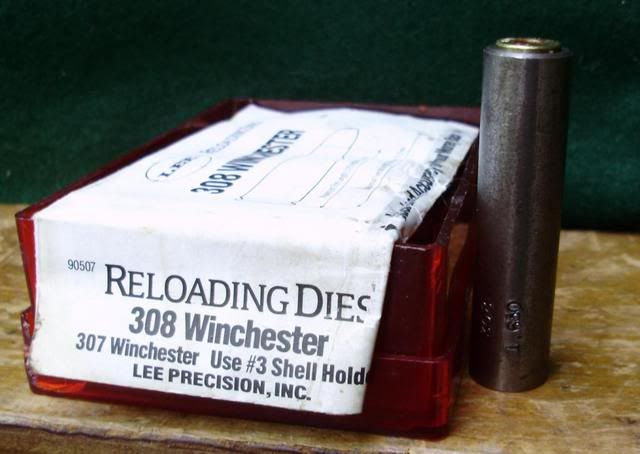 This is after resizing in my RCBS small base die. I could not find the RCBS box, so the case/gage are sitting on a Redding small base box. However, that little additional sizing removed the interference fit. 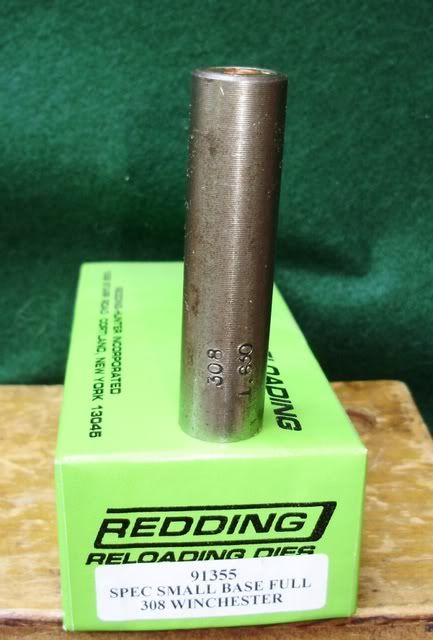 Sometimes cases are so ballooned that even a small base die won’t reduce the case to factory dimensions. It all depends on the chamber the round was fired in. I know it is extra effort to size cases with small base dies, if you use a good lube like Imperial Sizing wax or RCBS case lube, the effort is somewhat reduced. Still for all the extra bother involved in sizing with small base dies I'll do it for my Garands and M1a's. With those rifles I don’t want any resistance to chambering, I don’t want any delay to bolt closure. Because as the bolt stops and the lugs are turning, that darn free floating firing pin is just tapping the heck out of the primer. | |||
|
| one of us |
SlamFire Excellent tutorial on when and why one needs to use a small based resizing die. muck | |||
|
| One of Us |
My M1A doesn't bulge brass and I've never used a small base die in loading for it. I had a problem with closed bolt slam fires in my M1 Garand. Since I've gone to using a small base die in loading for it, I've had nary a problem. This is the only semiauto I've ever had to use a small base die in loading for and I've loaded for a number of them. | |||
|
| One of Us |
The M1A I'm speaking of is a late 2000's Scout model. I get a lot of loaded 308 GMM and American Eagle from work. I fire it and then look to use the brass if for a lot of other 308's I have. I've also never used small base dies and load lots of semi-auto in BAR, AR 5.56, AR 308, and AR 6.8. What I did notice was that after FL sizing (Redding die properly adjusted) I and loading for a relatively tight 308 hunting rig I have the case was very tight at the base. This is a Savage action with a 20" Mauser barrel nitrided. By relatively tight I mean I do not need to neck turn. I have never had a tight fit (barring OAL controlled by me) when using any other semi-auto or bolt gun to once fire and get some brass. So I figured it was the M1A expanded base. | |||
|
| One of Us |
Meant to add that I do have a 308 Wilson Case gauge...prog a good time to pull it out | |||
|
| One of Us |
“I have 308 and 30-6 gages, cut by Gene Barnett which are a little out of the ordinary. He cut these gages with his chambering reamer. Standard cartridge headspace gages are cut with a special reamer that is wide in the middle. A standard cartridge headspace gage measures length, not “fatness”. A reamer cut headspace gage will show you if the case is too long and too “fat” for that chamber” “ cut by Gene Barnett which are a little out of the ordinary “ I am sure someone can come up with a good reason for “a little out of the ordinary”. The shell holder deck height is .125” high, then there is the radius and case head protrusion and unsupported case head. I make chamber gages, I have take off barrels, all of the take off barrels have chambers, there is nothing ‘a little out of the ordinary’ about a chamber that has case head protrusion and unsupported case head, back to small base dies, I have small base dies, lots of them I still have BAR dies, I do not use them, but, ‘just in case’ I have small base dies. One more time, the deck height of the shell holder is .125” and there is the radius added to the case head thickness that no one measures, I have Remington 30/06 cases that have a case head thickness of .260”, I have Military 30/06 cases with a case head thickness of .200”. I had a trashy ole chamber from Winchester, the rifle was a model 70 chambered in 300 Winchester mag, Winchester’s rifle, Winchester’s own chamber, we had words, all I wanted was a chamber that fit my dies or Winchester dies that fit their chamber. They started out thinking I was difficult, in a few days they thought I was impossible. As I said, I have BAR 300 Winchester magnum dies, if their trashy old large chamber was shorter and smaller diameter there would be a very slight chance I could have used the BAR dies or the small base dies. I chambered new unfired Federal ammo in the rifle and fired them. I measured the dimensions of the new ammo before I fired them and again after I fired them. POINT? !!! The Federal ammo chambered flawlessly, I will stop right there. About the time someone thinks they need a small base die I suggest they measure the ammo they are firing before firing and again after firing, then there are those that can determine the difference between a standard sizing die and a small base die. If the case head on my Remington 30/06 cases is upset I have more problems than a small base die will solve, I was asked to bring the other set of shell holders when I offered to form a few hundred belted wildcats. I did, I took with me a shell holder adjuster, a small gasket cutting ball peen hammer. Seems about 40 of the cases that were to be formed where fired ‘a little too hot’ the case heads were upset, the extractor groove was was expanded .008” and the case body ahead of the belt had been expanded .011”. I did not offer to bring my small base dies, all three of us have lathes and collets, their choice, they choose not to include the 40 rounds. F. Guffey | |||
|
| One of Us |
I have an M1 converted to 308 Winchester. I bought some "hard" military primers for my M1A1. On a trip to the range for the first time with the converted M1, it would not fire the reloads with "Hard" primers. Put my other reloads with regular primers and it worked just fine. Rusty We Band of Brothers! DRSS, NRA & SCI Life Member "I am rejoiced at my fate. Do not be uneasy about me, for I am with my friends." ----- David Crockett in his last letter (to his children), January 9th, 1836 "I will never forsake Texas and her cause. I am her son." ----- Jose Antonio Navarro, from Mexican Prison in 1841 "for I have sworn upon the altar of god eternal hostility against every form of tyranny over the mind of man." Thomas Jefferson Declaration of Arbroath April 6, 1320-“. . .It is not for glory, nor riches, nor honours that we are fighting, but for freedom - for that alone, which no honest man gives up but with life itself.” | |||
|
| Powered by Social Strata |
| Please Wait. Your request is being processed... |
|

Visit our on-line store for AR Memorabilia

